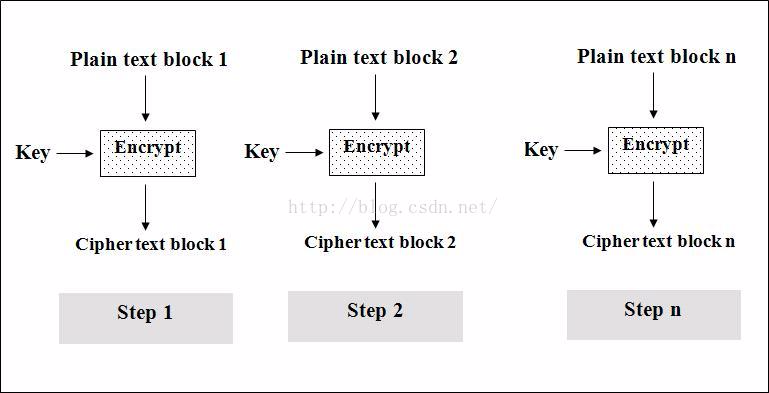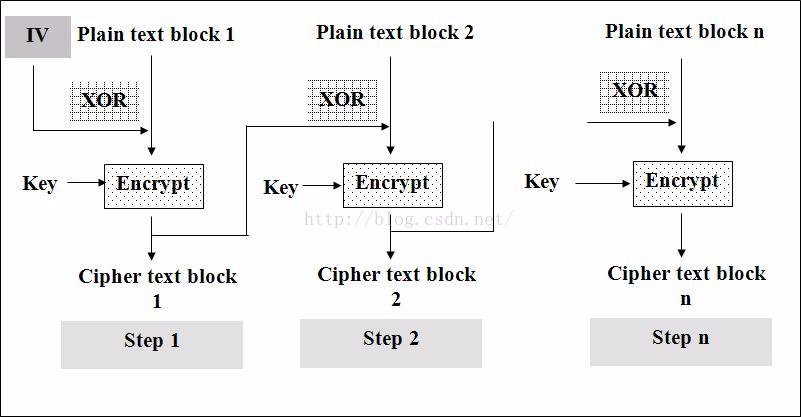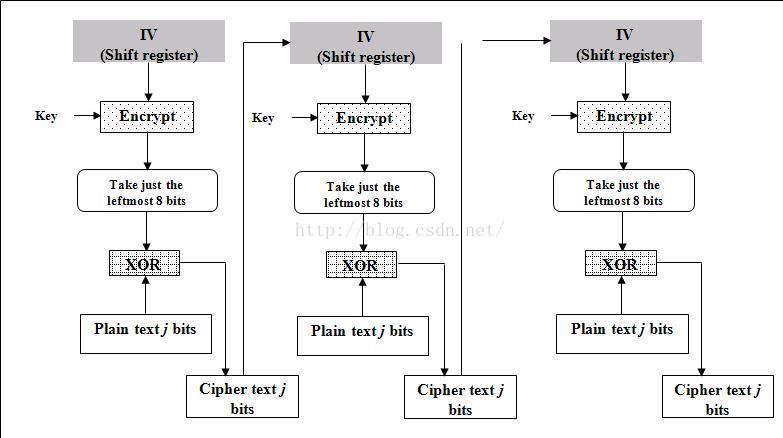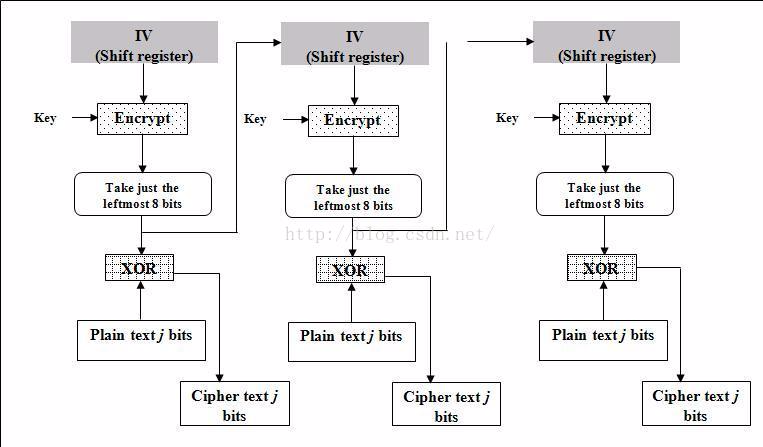一、概述
cryptosystem密码学系统分为私钥系统及公钥系统。
私钥系统:指加解密双方事先做了私有信息约定,采用对称密钥算法;
公钥系统:指发送方用公开凭证对数据进行加密后传输,接收方使用私有凭证进行解密,采用非对称密钥算法;
对称加密分类
流加密(stream cipher),加密和解密双方使用相同伪随机加密数据流,一般都是逐位异或或者随机置换数据内容,常见的流加密算法如RC4。
分组加密加密(block cipher),也叫块加密,将明文分成多个等长的模块(block),使用确定的算法和对称密钥对每组分别加密解密。
高级的分组加密建立以迭代的方式产生密文,每轮产生的密文都使用不同的子密钥,而子密钥生成自原始密钥。
数据加密中分组方式成为分组模式,如ECB;当加密中数据长度不足以满足分组时需要进行填充,此时采用的方式对应填充算法,如PKCS5Padding。
二、对称密钥算法
DES
Data Encryption Standard,数据加密标准,由IBM研究设计。
密钥长度8字节,有效位56bit;其中,分组为64bit=8字节。
3DES
DES像 AES过渡的加密标准。
由3个64bit的DES密钥对数据进行三次加密。
密钥长度为24字节,有效位168bit。
AES
Advanced Encryption Standard,高级加密标准。
包括AES-128;AES-192;AES-256算法,分组大小为128bit=16字节。
三、密码分组模式
1 ECB
Electronic Code Book,电码本模式
相同分组输出相同的密钥,简单且利于并行运算,但无法隐藏模式,也容易招致攻击

2 CBC
Cipher Block Chaining,密文分组链模式
需要初始化向量IV(长度与分组大小相同),第一组的密文与第二组数据XOR计算后再进行加密产生第二组密文
安全性较好,TLS、IPSec等标准的推荐模式,但不利于并行运算

3 CFB
Cipher Feedback,密文反馈模式 
4 OFB
Output Feedback (OFB),输出反馈模式 
三、填充算法
1 NoPadding,无填充算法,通常要求数据满足分组长度要求;
2 ZerosPadding,全部填充为0;
3 PKCS5Padding,填充字节数;
4 others…
DES像 AES过渡的加密标准
由3个64bit的DES密钥对数据进行三次加密
密钥长度为24字节,有效位168bit
四、代码示例
/**
* 加密工具类
*
* <pre>
* AES支持128/192/256,取决于密钥长度(与位数对应)
* DES密钥长度8字节
* 3DES密钥长度24字节
*
* 采用CBC 需指定初始向量IV,长度与分组大小相同
* DES为8字节;AES为16字节
*
* </pre>
*/
public class Crypto {
static {
// add bouncycastle support for md4 etc..
Security.addProvider(new BouncyCastleProvider());
}
public static enum CryptType {
DES_ECB_PKCS5("DES/ECB/PKCS5Padding"),
DES_CBC_PKCS5("DES/CBC/PKCS5Padding", 8),
DESede_ECB_PKCS5("DESede/ECB/PKCS5Padding"),
DESede_CBC_PKCS5("DESede/CBC/PKCS5Padding", 8),
AES_ECB_PKCS5("AES/CBC/PKCS5Padding", 16),
AES_CBC_PKCS5("AES/CBC/PKCS5Padding", 16),
AES_CBC_PKCS7("AES/CBC/PKCS7Padding", 16);
public final String algorithm;
public final String keyAlg;
public final int ivlen;
private CryptType(String algorithm, int ivlen) {
this.algorithm = algorithm;
this.keyAlg = this.algorithm.substring(0, this.algorithm.indexOf('/'));
this.ivlen = ivlen;
}
private CryptType(String algorithm) {
this(algorithm, 0);
}
@Override
public String toString() {
return this.algorithm;
}
}
/**
* Initialize the key
*
* @param type
* @return
*/
public static String initKey(CryptType type) {
try {
KeyGenerator generator = KeyGenerator.getInstance(type.keyAlg);
SecretKey secretKey = generator.generateKey();
byte[] key = secretKey.getEncoded();
return Codec.byteToHexString(key);
} catch (Exception e) {
throw new RuntimeException(e);
}
}
/**
* generate default ivparam for type
*
* @return
*/
public static byte[] generateDefaultIv(CryptType type) {
byte[] iv = new byte[type.ivlen];
for (int i = 0; i < iv.length; i++) {
iv[i] = 0x01;
}
return iv;
}
/**
* Encrypt the value with the encryption standard.
*
* @param value
* raw string
* @param key
* in hex format
* @param iv
* in hex format if exist
* @param type
* @return result in hex format
*/
public static String encrypt(String value, String key, String iv, CryptType type) {
byte[] dvalue;
try {
dvalue = value.getBytes("utf-8");
} catch (UnsupportedEncodingException e) {
throw new RuntimeException(e);
}
byte[] dkey = Codec.hexStringToByte(key);
byte[] div = null;
if (iv != null && iv.length() > 0) {
div = Codec.hexStringToByte(iv);
}
byte[] result = encrypt(dvalue, dkey, div, type);
return Codec.byteToHexString(result);
}
/**
* Encrypt the value with the encryption standard.
*
* <pre>
* key must have the corresponding length.
*
* if use cbc mode which need iv param, the iv must not be null,
* and iv data length is 16 for aes, 8 for des
*
* </pre>
*
* @param value
* @param key
* @param iv
* @return
*/
public static byte[] encrypt(byte[] value, byte[] key, byte[] iv, CryptType type) {
try {
SecretKeySpec skeySpec = new SecretKeySpec(key, type.keyAlg);
Cipher cipher = Cipher.getInstance(type.algorithm);
IvParameterSpec ivparamSpec = null;
if (iv != null) {
ivparamSpec = new IvParameterSpec(iv);
}
cipher.init(Cipher.ENCRYPT_MODE, skeySpec, ivparamSpec);
return cipher.doFinal(value);
} catch (Exception ex) {
throw new RuntimeException(ex);
}
}
/**
* Encrypt the value with the encryption standard.
*
* @param value
* encoded data in hex format
* @param key
* in hex format
* @param iv
* in hex format if exist
* @param type
* @return result raw string
*/
public static String decrypt(String value, String key, String iv, CryptType type) {
byte[] dvalue = Codec.hexStringToByte(value);
byte[] dkey = Codec.hexStringToByte(key);
byte[] div = null;
if (iv != null && iv.length() > 0) {
div = Codec.hexStringToByte(iv);
}
byte[] result = decrypt(dvalue, dkey, div, type);
try {
return new String(result, "utf-8");
} catch (UnsupportedEncodingException e) {
throw new RuntimeException(e);
}
}
/**
* Decrypt the value with the encryption standard.
*
* <pre>
* key must have the corresponding length.
*
* if use cbc mode which need iv param, the iv must not be null,
* and iv data length is 16 for aes, 8 for des
*
* </pre>
*
* @param value
* @param key
* @param iv
* @param type
* @return
*/
public static byte[] decrypt(byte[] value, byte[] key, byte[] iv, CryptType type) {
try {
SecretKeySpec skeySpec = new SecretKeySpec(key, type.keyAlg);
Cipher cipher = Cipher.getInstance(type.algorithm);
IvParameterSpec ivparamSpec = null;
if (iv != null) {
ivparamSpec = new IvParameterSpec(iv);
}
cipher.init(Cipher.DECRYPT_MODE, skeySpec, ivparamSpec);
return cipher.doFinal(value);
} catch (Exception ex) {
throw new RuntimeException(ex);
}
}
}
key 长度受限问题
Exception in thread "main" java.security.InvalidKeyException: Illegal key size or default parameters
问题原因:因软件出版政策原因,默认 jdk 环境做了限制,当AES加密密钥大于128位时,会出现以上异常;
解决办法:下载JCE扩展,替换至 ${java_home}/jre/lib/security
http://www.oracle.com/technetwork/java/javase/downloads/index.html
五、参考文档:
http://m.blog.csdn.net/article/details?id=51066799
http://www.blogjava.net/amigoxie/archive/2014/07/06/415503.html